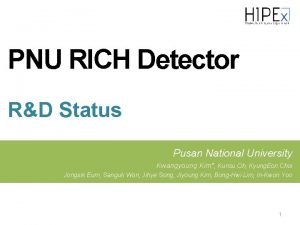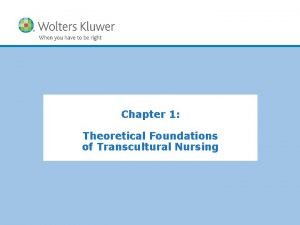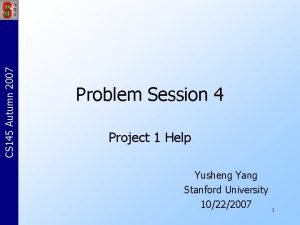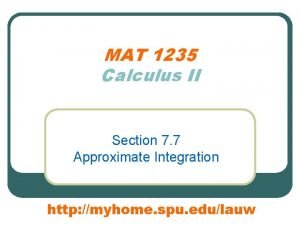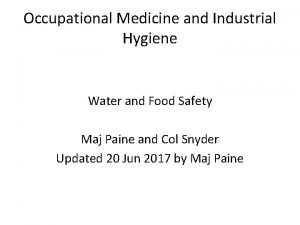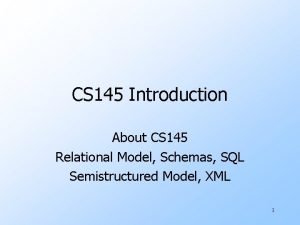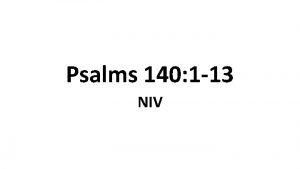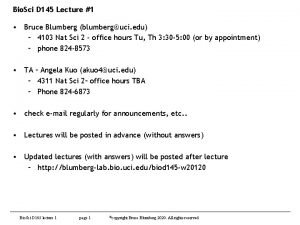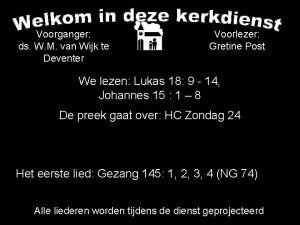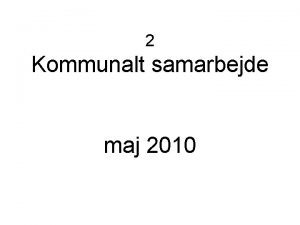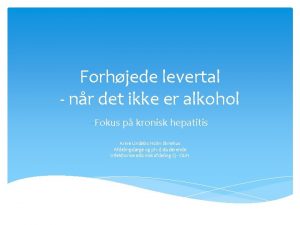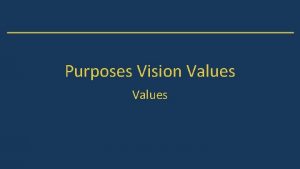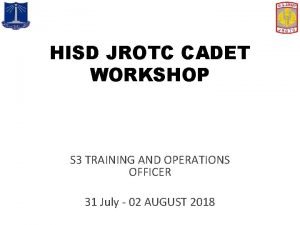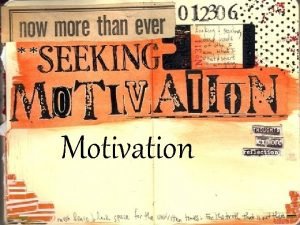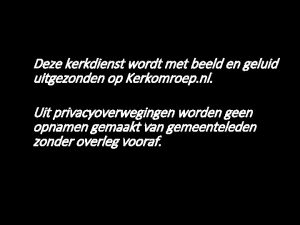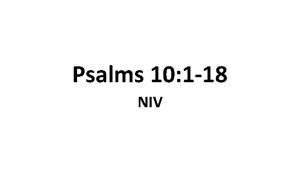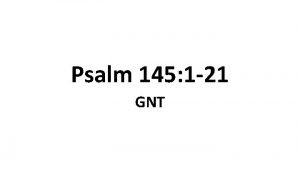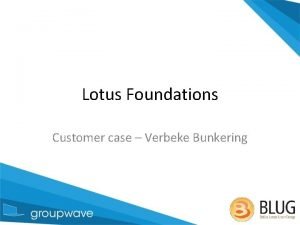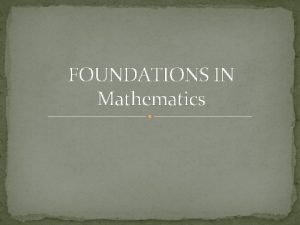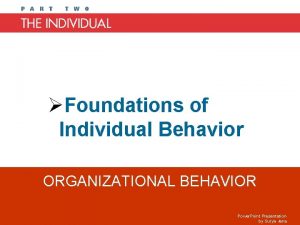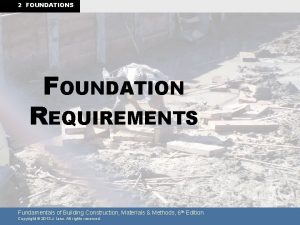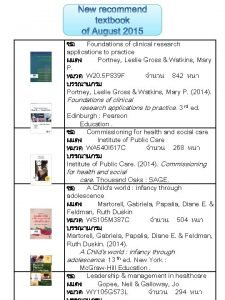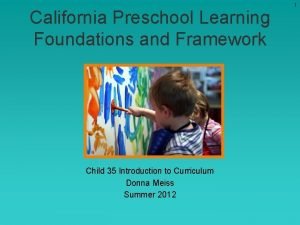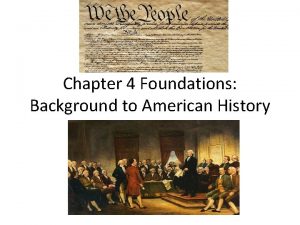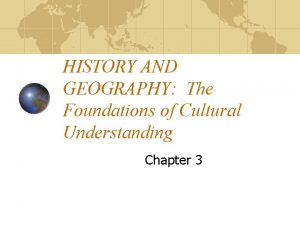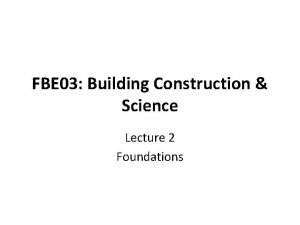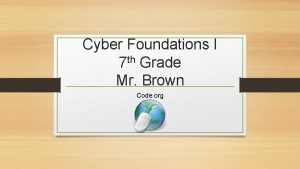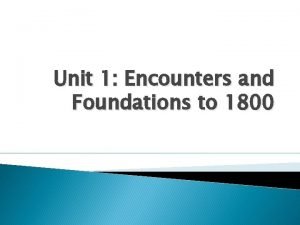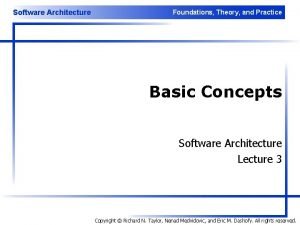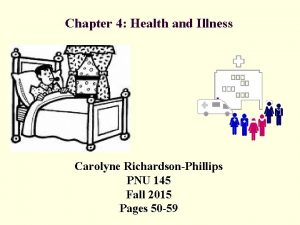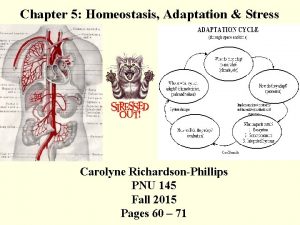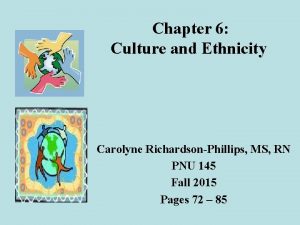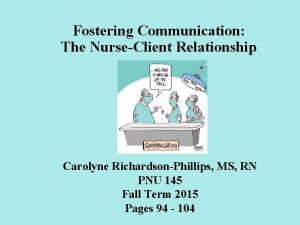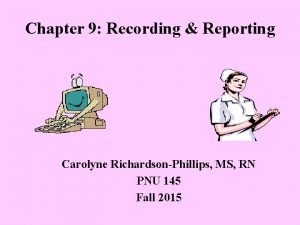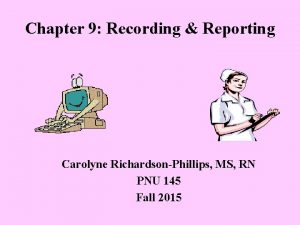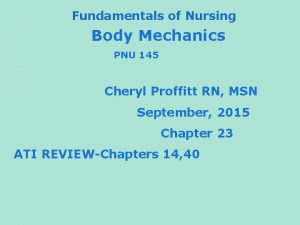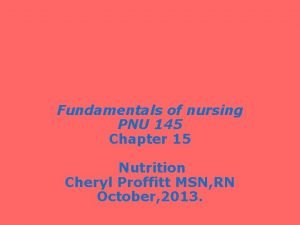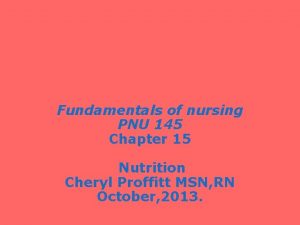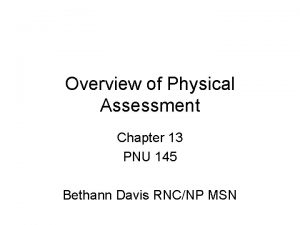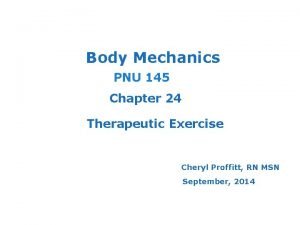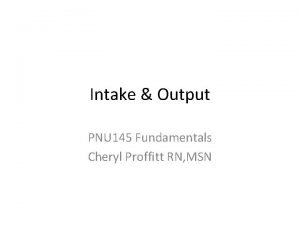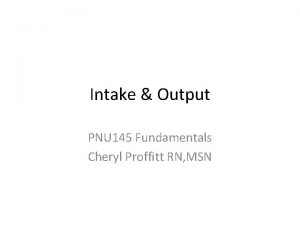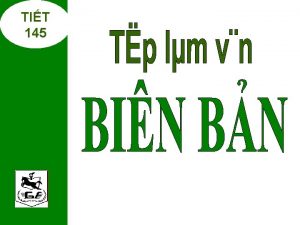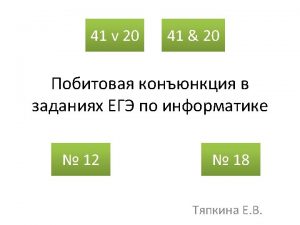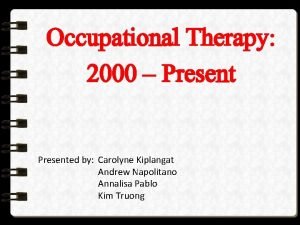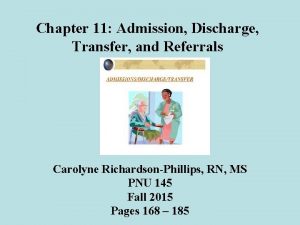Nursing Foundations Carolyne RichardsonPhillips MS RN PNU 145

































































- Slides: 65

Nursing Foundations Carolyne Richardson-Phillips, MS, RN PNU 145 Fall 2015

Learning Outcomes By the end of the section, the PN Students will be able to: • Discuss Florence Nightingale’s reformation and contributions to nursing • Discuss the historical progress of Nursing in the United States • Discuss the components of nursing theory • Compare the similarities and differences of 4 nursing theories and the applications to nursing • Discuss Nursing’s educational ladder, approval, accreditation, and practical nurse education • State the rationales for acquiring Continuing Education • Describe the levels of responsibilities that Licensed Practical Nurses perform using nursing process • Identify current and future trends of health care affecting nursing, the client and family • Discuss proactive nursing strategies • Discuss unique nursing skills nurses use in clinical practice

Nursing Historical Origins • Nursing: youngest profession but Oldest art (assisting people) • Evolved from roles of nurturing & caretaking • Women-Early responsibilities-helping out with childbirth, feeding newborns, attending to the ill, aged, the helpless within homes & community settings • Origin stood for Caring more than Curing • Roman Empire-First hospital established • Middle ages- religious groups (Catholic) performed nursing care. Priests regarded as physicians • Christian values of “love thy neighbor as thyself” • Nursing care changed D/T a feud between King Henry VIII & Catholic Church • England took over nursing care of the sick • Hospitals became poor houses • Workers were: criminals, orphans, widows • Workers paid back the Crown for their food, shelter, by tending to the sick

History Of Men in Nursing • • • First nurses throughout the world First nursing school was in India 250 BC Only men were felt to be pure enough to be nurses Military, religious & lay orders of men continued to provide nsg care during the Middle Ages; some of the most famous: the Knights Hospitals, the Teutonic Knights, the Tertiaries, the Knights of St. Lazarus, the Order of the Holy Spirit & the Hosp Brothers of St. Anthony St Camillus (25 May 1550 – 14 July 1614) invented the symbol of the red cross and created the first ambulance service (was an Italian priest who founded a religious Order dedicated to the care of the sick) Crusades saw formation of knights-provided nursing care-built hospitals During the Black Plague, a group of men formed one of the first hospitals to care for the victims In 1783 James Durham, a slave from New Orleans, earned his freedom by working as a nurse; later became one of the first black MD in the US Walt Whitman (1819 -1892), a poet and a writer, volunteered as a hospital nurse in Washington, DC during the Civil War.

History of Male Nurses Cont. • First American Nurse • Friar Juan de Mena----first identified nurse in what was to become the U. S. (Seventy years before the Pilgrims landed on Plymouth Rock; Mena-was shipwrecked off the coast of Texas) • First Massachusetts nurse: Frank Bertram in 1896 • In the early 1900's- Men were excluded from nursing in the military- did not resume this function until the early 1950's, after the Korean War • Nursing Schools For Men - Mills School for Nursing and St. Vincent's Hospital School for Men- founded in New York in 1888 • Pennsylvania Hospital opened a school for female nurses in 1914 and simultaneously opened a separate men’s nursing school

Nightingale Reformation • Florence Nightingale • Founder of Modern Nursing • Crimean War 1854 -1856 • British casualties high, Arrived at hospital with 38 Nurses, cleaned up filth, improved environment • Helped control infection & reduced death rate from 60% to 1% 1820 -1910

Florence Nightingale (cont’d) • Called “Lady with the Lamp” • Acted as a banker, sending men's wages home to families, wrote home on behalf of soldiers • Introduced reading rooms to hospital • When returned to England received money and started the first NURSING SCHOOLS

Florence Nightingale’s Contributions to Nursing • Changed negative image of Nursing to a positive one • Contributions • Trained women for future work • Selective- only those with upstanding characteristics for a potential nurse • Identifying client’s needs and how nurses could meet them • Improving sanitation conditions for sick & injured in the filed and hospitals • Reduced death rate of British soldiers • Establishing nursing education-Provided classroom & clinical (skills) teaching • Advocated for life-long nursing education • Good documentation •

Nursing in the United States • Civil War: around the same time as Nightingale’s reformation • United States- No organized or trained nursing staff • Military relied on untrained corpsmen, civilian volunteers • Nursing Leader-Dorothea Dixnoted social reformer of the mentally ill • Volunteered to form an Army Nursing Corps • Convinced skeptical Military officials, that women could perform the work acceptably D. Dix-1802 -87

Nursing in United States (cont’d) • In 1862, Dorothea followed Nightingale’s advice; established a selection criteria for potential nurses • Dix’s requirements • Not be flighty and marriage-minded young women • Only accepted applicants who were matronly, plain looking • Ages 30 to 50 • Needed to be educated, neat, orderly, sober, have a serious disposition • Be industrious-Applicants-needed 2 letters of recommendation attesting to their moral character, integrity, and capacity to care for the sick • Had to agree to serve for at least 6 months • Dress code of modest black or brown or gray skirts and forbade hoops or jewelry.

Nursing in the United States (cont’d) • Nursing Leader • Civil War nurse • Establish hospitals • Cared for soldiers on both sides of the battle field • Known as “Angel of the Battlefield” • Founder of American Red Cross in 1882 Clara Barton-1821 -1912

U. S. Nursing Schools • After Civil War-established training schools for nurses • Standards deviated from Nightingale’s which were planned, consistent, formal education • U. S. training- unsubsidized apprenticeship • Later, U. S. curricula & content training improved became more organized & uniform • Longer training time established • Graduate nurses-received diplomas

Nursing in the United States Cont. • Lillian Wald (1867 -1940) • Nursing Leader • Established/Opened a neighborhood service for the poor sick - Henry Street Settlement in New York City • First community health nurse in US • Considered the founder of Public Health Nursing (VNA today)

Contemporary Nursing: Combining Nsg Art w/ Science • Beginning of nursing education consisted of learning the ART – ability to perform an act skillfully • Learned by watching & imitating the techniques performed • Mentors passing nursing skills to students • Contemporary Nursing added another dimension: Science-body of knowledge unique to a particular subject • Science: develops from observing & studying the relation of one phenomenon to another • Developing a unique body of knowledge, now possible to predict which nursing interventions that may produce the desired outcomes

Integrating Nursing Theory • Theory: opinion, belief, or view that explains a process (provides an orderly way) • Nightingale & others-examined relationships among humans, health, the environment & nursing-outcomes of this analysis becomes basis for Nursing theory • Nursing theory – proposed ideas about what is involved in process identified as nursing • Purposes of nursing theory: define nursing, describe what nurses do and provide goals or outcomes of care • Components: • Nursing: • Patient/Client: • Health: • Environment:

Integrating Nursing Theory (cont’d) • Nursing programs adopt-theory: • serves as conceptual framework or model for philosophy, curriculum, and importantly nursing approach to clients • Some of the many theories: 1. Environmental theory -Nightingale 2. Basic Needs theory -Henderson 3. Self-Care theory -Orem 4. Adaptation theory -Roy

Nursing Model: Nightingale • What is Florence Nightingale’s contribution to nursing theory? • Recognized as the first nurse Theorist • Described nursing as both an art and a science • Environmental Theory • Recommended adjusting the environment to improve the person’s health • Application to Nursing Practice NURSING- modify unhealthy environment to put client in best condition for nature to act

Nursing Model: Virginia Henderson • Basic Needs Theory • Definition of Nursing-adopted by International Council of Nurses • Included health promotion-not just illness care • Application to Nursing Practice • Nurses- assist in performing activities that client would perform if had strength, will, knowledge • Do this in such a way as to help them gain independence as soon as possible 1897 -1996

Nursing Model: Dorothea Orem • Self-Care Theory • Focuses on each individual’s ability to perform self-care (Optimal level of selfcare) • Defined as 'the practice of activities that individuals have learned -initiate and perform on their own behalf in maintaining life, health, and well-being • Person (client/patient) external elements that man interacts on the struggle to maintain self-care environmental situations 1914 -2007

Dorothea Orem (cont’d) Areas Applicable to Self-Care Theory • Direct nursing care (nurse has direct contact with client/family • Providing care or teaching in the following areas • Nutrition and weight control • Hygiene • Mobility –exercise & physical fitness • Medications • Behavior - stress management • Maintenance of social support systems • Environmental control • Application to Nursing Practice Nurses-assist clients with self-care to improve or to maintain health

Nursing Model: Sr. Callista Roy • Adaptation Theory: • Model provides a way of thinking about people & their environment that is useful in any setting • Helps one prioritize care and challenges the nurse to move the patient from survival to transformation • Major Concepts: • Person or group as an adaptive system to changes in environment • Environment as internal and external stimuliin continuous state of change • Application to Nursing Practice • Nurses assess biologic, psychological, & social factors interfering w/ health; help w/ altering the stimuli causing the maladaptation • Then evaluate the effectiveness of the action taken 1939 to present

Psychosocial Development Theorists • Research related to human motivation Abraham Maslow (1954) A hierarchy of human needs • Based on two groupings: • deficiency needs • growth needs • Within the deficiency needs, each lower need must be met before moving to the next higher level

Maslow (cont’d) 1. 2. 3. 4. 5. Physiological: hunger, thirst, bodily comforts, etc. Safety/security: out of danger; Belonging and Love: affiliate with others, be accepted; and loved Esteem: to achieve, be competent, gain approval and recognition Cognitive: to know, to understand, and explore; and Aesthetic: symmetry, order, and beauty 6. Self-actualization: to find self-fulfillment and realize one's potential; and 7. Self-transcendence: to connect to something beyond the ego or to help others find self-fulfillment and realize their potential

Psychosocial Development Theorists • 8 stages of Psychosocial Development • Expanded Freud’s theory of development to include entire life span • Believed people continue to Develop • Nurses: be aware of positive & negative resolutions for each stage • Developmental stage • Help client develop coping skills • Strengthen client’s attitude by providing encouragement ** Environment- highly influential in development Erikson

Erickson’s Stages • • Stage 1 - Hope -Infant stage - Basic Trust vs. Mistrust Stage 2 -Toddler stage -Will - Autonomy vs. Shame and Doubt Stage 3 - Kindergarten- Purpose - Initiative vs. Guilt Stage 4 - Around age 6 to puberty- Competence - Industry vs. Inferiority Stage 5 - Teenager- Fidelity - Identity vs. Role Confusion Stage 6 - Young adult-Love -Intimacy vs. Isolation Stage 7 - Mid-life crisis-Caring - Generativity vs. Stagnation Stage 8 - Old age wisdom - Ego Integrity vs. Despair

Defining Nursing • Nightingale-earliest definition--“putting individuals in the best possible condition for nature to restore and preserve health” • Henderson-definition adopted by The International Council of Nurses---Nursing involves a special relationship and service between the nurse and client • Nursing’s Social Policy Statement 3 rd ed. (2010) American Nurses Association (ANA) defines nursing as • Protection, promotion, optimization of health & abilities • Prevention of illness & injury • Alleviate suffering through diagnosis & treatment of human response • Advocate the care of individuals, families, communities & populations

Defining Nursing (cont’d) • ANA (2010) –Six essential features added – 1. Provision of a caring relationship that facilitates health and healing – 2. Attention to the range of human experiences and responses to health and illness within the physical and social environments – 3. integration of objective data with knowledge gained from an appreciation of the client’s or group’s subjective experience – 4. Application of scientific knowledge to the processes of diagnosis and treatment through the use of judgment and critical thinking – 5. Advancement of professional nursing knowledge through scholarly inquiry – 6. Influence on social and public policy to promote social justice • ANA: nursing has an independent area of practice in addition to traditional dependent & interdependent functions involving MDs

The Educational Ladder • Lavinia L. Dock Established the National League for Nurses (NLN)– NLN -Responsible for accreditation of nursing schools • Education – Practical (Vocational) Nursing – Registered Nursing • Each program provides knowledge and skills for a particular entry level of practice

Practical/Vocational Nursing • Abbreviated nursing program created during WWII • 1892 -First training for LPNs (YWCA) • 1893 - Ballard School -First school for LPNs • Program was 3 months long • Goal: prepare graduates to care for health needs of infants, children, & adults -mildly or chronically ill or convalescing • 1941 -Formed the National Association for Practical Nurse Education and Service, Inc. (NAPES) • Worked to standardize the program & to facilitate licensure of graduates

Practical/Vocational Nursing (cont’d) • Once education completed-qualified to take licensing examination. NCLEX-PN National Council Licensure Examination for Practical Nurses (NCLEX-PN)) • LPNs – Scope of Practice under the Nurse Practice Act of the state they are working in • Performing skills may differ from state to state • LPN/LVN-work under supervision of a RN, physician, dentist, NP • May supervise unlicensed and or licensed assistive personnel • Career mobility-offer path to RN via Associate or Baccalaureate degrees

Registered Nurse • Students can choose one of 3 paths 1. Hospital-based diploma 2. Associate degree 3. Baccalaureate * Once educated- may take NCLEX-RN National Licensing Examination • Work under supervision of a physician, NP, or dentist in various settings-preventative to acute – Educate clients and public – May work directly at bedside or supervise others (delegate care to others)

Hospital-Based Diploma Programs • Diploma programs –traditional route- thru middle of 20 th century – 1873 Linda Richards first nurse to be given a diploma from the New England Hospital for Women and Children. She is identified as "the first trained nurse" in the U. S. – Programs have become less – Reasons – movement to increase professionalismcolleges/universities, hospitals can no longer support nursing programs – Diploma nurses: well trained, vast clinical experience – Hospital-based program-last 3 years – Can transfer credits-science & Humanities courses to Pursue associate and or baccalaureate degrees

Associate Degree Program • Mildred Montag- advocated the creation of an associate degree in nursing – 2 year program • Nurse –referred to as a technical nurse – would not be working in a management Position * * Once educated-may take NCLEX-RN National Licensing Examination

Baccalaureate Program • ANA & National League for Nursing pushing for this program to be entry level for all nurses • Longest program & most expensive • Nurses have greater flexibility qualifying for jobs-staff & managerial * These nurses are preferred in areas where need for independent decision making

Graduate Nursing Programs • Master’s and Doctoral levels • Master’s prepared-clinical specialists nurse practitioners, administrators, educators • Doctoral prepared-conduct research and advise, administer, & instruct nurses pursuing undergraduate and graduate degrees

Delegation-LPN/LVN -RN • Delegation-Six guidelines 1. Right task: matching the client’s needs with the caregiver’s skills 2. Right circumstance: ensuring that the situation is appropriate 3. Right person: knowing the unique competencies of the caregiver 4. Right direction (communication): providing sufficient information 5. Right supervision: being available for assistance 6. Right follow-up: validating that the task was completed, obtaining the results, and analyzing if further actions are necessary

Continuing Education (cont’d) • Any planned learning experience that takes place beyond basic nursing program – 1. No program provides all the knowledge or skills needed for this lifetime career – 2. New advances in technology better than old ones – 3. Assuming responsibility for self-learning shows personal accountability – 4. Nurses need to demonstrate evidence of competence to maintain consumer’s confidence – 5. Practicing nursing care according the current nursing standards helps to ensure care is legally safe – 6. Many states require nurses to show proof of continuing education to renew their nursing license • Learning- lifelong process

Future Trends • Two major issues: – 1. Elimination of shortage of nurses – 2. Strategies for responding to a growing aging population with chronic health problems • Shortage-retirement, attrition of aging faculty, disappointing salaries, job dissatisfaction • Client-to-nurse ratios • More high-acuity clients, heavier work loads, • mandatory overtime, • Downsizing nursing staff • Continuous health care costs & reimbursements • Information & Telecommunications

Government Responses • Federal Gov-tried to help with the shortage – Passed-American Recovery & Reinvestment Act: 1. Loan repayment programs & scholarships 2. Funding public service announcements to encourage people to enroll into nursing 3. Career ladder programs 4. Establishment of nurse retention & client safety enhancement grants 5. Grants to incorporate gerontology into curricula of nursing programs 6. Loan repayment program for nursing students who agree to teach following graduation

Proactive Strategies • Nurses are taking up the challenge: – Switching from part-time to full-time – Delaying retirement – Pursuing post-licensure education - Training for advanced practice - Becoming cross-trained - Learning more about multi-cultural diversity - Supporting legislative efforts - Promoting wellness programs - Helping clients with chronic diseases - Referring clients with health problems for treatment - Discharge planning- clinical pathways - Participating in quality assurance - Concentrating on continuing knowledge and skills

Levels of Responsibilities for Nursing Process • Assessing-gathers data • Diagnosing • Planning-Setting realistic goals - Suggests interventions - Assists in writing plan of care • Implementing- Performs basic nursing care • Evaluating-shares observations on how well or not –client is doing and adjusts plan of care as needed

Unique Nursing Skills • Assessment skills –need to determine client’s needs & problems – Involves collecting data-Interviewing, observing, & examiningclient and or family or both – Review medical record, talk with other health care workers

Unique Nursing Skills (cont’d) • Comforting Skills- illness causes feelings of insecurity • Insecurity may threatened client and or family’ ability to cope • Nurse uses comforting skillsinterventions that provide stability and security during a healthrelated crisis • Nurse becomes-guide, companion, interpreter • Nurse helps to reduce fear, worry and instills trust

Standards of Care • Nurse Practice Act -Legal acts-laws established in each state and province to define scope of nursing practice and regulate/govern the profession in the United States – Practice acts differ from state to state, but have a common purpose, to protect the public • Standards of Nursing Practice: allow nurses to carry out professional roles and serves as protection for nurses, patients and institutions – Purpose- describe the responsibilities for which nurses are accountable

Standards of Care (cont’d). . • The National Federation of Licensed Professional Nurses (NFLPN)is the professional organization for licensed practical nurses and licensed vocational students/nurses in the United States: • National Federation of Licensed Practical Nurses, Inc, have identified standards: - Education - Legal / Ethical status - Practice - Continuing education - Specialized nursing practice

Professional Organizations-LPN • American Licensed Practical Nurses Association • National Association for Practical Nurse Education and Service • The National Federation of Licensed Professional Nurses (NFLPN)

References • Civil War Nurses Retrieved May 1, 2014 from web site: http: //www. topics. nurse. com/civilwar * Dorothea Dix Bibliography Retrieved May 1, 2014 from web site: http: //www 2. webster. edu/~woolflm/dorotheadix. html * Erikson Retrieved on 5/1/14 from web site: http: //www. simplypsychology. org/Erik-Erikson. html * Florence Nightingale Retrieved 2007 from web site: http: //nursing-theory. org/nursing-theorists/Florence-Nightingale. php Dorothea Orem. Retrieved 5/1/14 from web site: http: //nursingtheory. org/nursing-theorists/Dorothea-E-Orem. php • LPN history Retrieved on 5/1/14 from web site: http: //www. ehow. com/about_5452553_history-licensed-practicalnurses. html • Men in nursing Retrieved 8/21/14 from web site: http: //allnurses. com/men-in-nursing/men-nursing-historical-96326. html. • Timby, B. K. , (2013) (10 th ed). Fundamental Nursing Skills and Concepts. Philadelphia: Lippincott Williams & Wilkins

Historical Pictures of Nursing Nurses in Uniform Nursing at Bedside Student Nurses

Graduating Nurses VNA Nurses 1930

Community Health Nurses

Visiting Nurses


Korean War Nurse


Female & Male Nurses in Iraq

History Male Nurses

Syringe & Needle Medicines

Maternity Instruments Breast Pump

Surgical Instruments 1800 eye surgery

Hearing aid Leeches

Stethoscopes Orthopedic Hammer Vaccination needle

Bedpans & Utensils

Surgical Instruments 1800 - 1855 Dental drill

Civil War Instruments Ancient Roman Surgical Instruments

Surgeon's chest on board Mayflower.
 Pnu korea
Pnu korea Outlook pnu
Outlook pnu Pnu point
Pnu point Transcultural interprofessional practice model
Transcultural interprofessional practice model Stanford cs 145
Stanford cs 145 Jar 145
Jar 145 7.145-2.766
7.145-2.766 Afman 48-149
Afman 48-149 Supercade-suba (2) -avenida calle 145 no.103b-90
Supercade-suba (2) -avenida calle 145 no.103b-90 Cs 145
Cs 145 Psalm 145 15
Psalm 145 15 Psalm 23 niv
Psalm 23 niv Pasal 145 kuhap
Pasal 145 kuhap 600 e yuvarlanan sayılar
600 e yuvarlanan sayılar Cs 145 uci
Cs 145 uci 145 iq percentile
145 iq percentile Psalm 145:1-21
Psalm 145:1-21 Gcf of 34
Gcf of 34 Réglementation part 145
Réglementation part 145 Gezang 145
Gezang 145 Gezang 145
Gezang 145 Psalm 145 nlt
Psalm 145 nlt 145+10
145+10 Afi 48-146
Afi 48-146 Generel helbredsattest
Generel helbredsattest Basisk fosfatase normalværdi
Basisk fosfatase normalværdi Psalm 145 13 niv
Psalm 145 13 niv Eee 145
Eee 145 Psalm 76 tpt
Psalm 76 tpt Naviance hisd
Naviance hisd Easa foreign part 145
Easa foreign part 145 Math 145
Math 145 145+(-45)=a. berapa nilai a
145+(-45)=a. berapa nilai a 5 4 145 lbs woman
5 4 145 lbs woman Math 145
Math 145 Psalm 145 vers 2
Psalm 145 vers 2 Psalm 145 13 niv
Psalm 145 13 niv Bda-145
Bda-145 Psalm 145 1
Psalm 145 1 Ephesians 1:7-9
Ephesians 1:7-9 Nursing management of cataract
Nursing management of cataract Nursing interventions for neonatal abstinence syndrome
Nursing interventions for neonatal abstinence syndrome Team nursing model
Team nursing model Nursing process in psychiatric nursing
Nursing process in psychiatric nursing Post operative nursing management
Post operative nursing management Lotus bunkering
Lotus bunkering Multinational financial management definition
Multinational financial management definition Preschool learning foundations math
Preschool learning foundations math Unit 1 foundations of american government
Unit 1 foundations of american government Foundations of individual behavior
Foundations of individual behavior Fundamentals of building construction chapter summaries
Fundamentals of building construction chapter summaries Chapter 2 foundations of resident care
Chapter 2 foundations of resident care Foundations of clinical research applications to practice
Foundations of clinical research applications to practice Preschool learning foundations volume 1
Preschool learning foundations volume 1 Chapter 4 foundations background to american history
Chapter 4 foundations background to american history Max ringelman
Max ringelman History and geography the foundations of culture
History and geography the foundations of culture Aohs foundations of anatomy and physiology 1
Aohs foundations of anatomy and physiology 1 Wide strip foundations
Wide strip foundations The foundations logic and proofs
The foundations logic and proofs Cyber foundations
Cyber foundations Encounters and foundations to 1800
Encounters and foundations to 1800 Mathematical foundations of computer graphics and vision
Mathematical foundations of computer graphics and vision Software architecture foundations theory and practice
Software architecture foundations theory and practice Domain specific software architecture
Domain specific software architecture Preschool learning foundations volume 3
Preschool learning foundations volume 3

